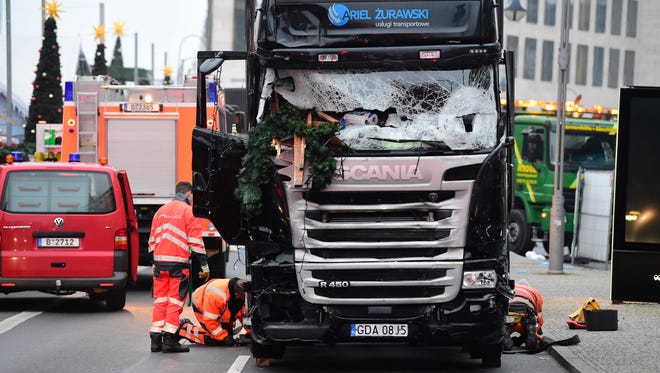Berlin attack latest in disturbing terror trend
 Alan Gomez
Alan GomezIf the truck attack on a crowded Berlin market that killed a dozen people sounded familiar, that's because it follows a disturbing trend of terrorism that requires little organization, manpower or technological know-how.

Whether the Berlin rampage represents the latest lone wolf attack or is the latest example of an Islamic State operative able to conceal his ties to the terrorist organization worries authorities.
German officials are still searching for the unknown driver who plowed a truck loaded with steel beams into a popular Christmas market Monday night. Whatever his identity, his method has become commonplace.
ISIL calls Berlin attacker a 'soldier' as manhunt for killer resumes
In July a Tunisian resident of France, Mohamed Lahouaiej-Bouhlel, used a rented cargo truck to run through a crowd in Nice, France, killing 86 people and wounding hundreds more. And Abdul Razak Ali Artan, a Somali-born student at Ohio State University, crashed his car into a crowd of pedestrians in November before getting out and stabbing several of them with a butcher knife.
Rita Katz, executive director of the SITE Intelligence Group, said the Islamic State has been heavily promoting the use of trucks in recent years. The group even dedicated a three-page feature in the November edition of its online magazine explaining the right way to carry out such an attack, including a picture of a U-Haul truck, a list of suggested targets and tips on what kind of truck to use.

"It's important to understand that these materials aren't just distributed on the Deep Web jihadi forums," said Katz, referring to portions of the Internet not easily found through traditional search engines. "They are all over social media and extremely easy to obtain."
U.S. cities bolster security following Berlin attack
The magazine feature is one example of the Islamic State's improved methods of communications, according to Daniel Milton, research director at the Combating Terrorism Center at West Point. Milton said the Islamic State is light years ahead of the grainy propaganda videos used by al-Qaeda that mostly featured inspirational messages to encourage recruits to find their way to an al-Qaeda training camp.
Now, the Islamic State, also known as ISIL or ISIS, uses social media, its online magazine and instructional videos to teach would-be supporters how to do everything from choosing the right knife to picking the ideal target. Milton said that has inspired many "lone wolves" who need no formal contact with the Islamic State to inflict their own terror. And with the battle in Syria continuing to rage, he said there's plenty of anti-Western motivation.
"ISIS has been far better at mobilizing people using interesting and provocative propaganda than any group we've ever seen," Milton said. "You see them putting a better pitch out there, and people are responding to that."
Other security experts see something else going on.
Daveed Gartenstein-Ross, a senior fellow at the Foundation for Defense of Democracies, said many Islamic State followers are incorrectly labeled lone wolves because there is little evidence showing any direct contact with the militant group. Maybe the attackers have never been to a country known to house terrorist training camps, or maybe there's no sign they communicated with an Islamic State operative online or over the phone.
But Gartenstein-Ross said the anonymity of social media and easy access to encryption software has made it easier for people to have regular conversations with terrorism groups without raising suspicions from law enforcement.
"You can be in touch with a lot of operatives now," he said. "It's not the immediate go-to-jail card that it used to be."
Gartenstein-Ross is focusing on the timing of the Berlin attack.
The Islamic State has made a habit of clustering attacks around holidays. He said the militant group attempted a series of attacks last year around New Year's Eve that were disrupted by intelligence agencies. He said an intended attack around the Easter turned into the Brussels attack, when three suicide bombings killed 32 people on March 22. A coordinated attack around Ramadan was also carried out, including a car bombing in Iraq that killed more than 300 people.
German media say boy, 12, planned twin bomb attacks
He sees a similar pattern leading up to Christmas and New Year's. Last week, German officials claimed a 12-year-old boy tried to set off dual bombs near a Christmas market in the southern city of Ludwigshafen. Monday's attack in Berlin could have been the next step of the Islamic State's holiday campaign, according to Gartenstein-Ross.
The Islamic State's Amaq News Agency added to that theory Tuesday, claiming responsibility for the Berlin attack, calling the unknown driver who's still at-large a "solider of the Islamic State."
"It's possible that we already are seeing a cluster in Germany," Gartenstein-Ross said.